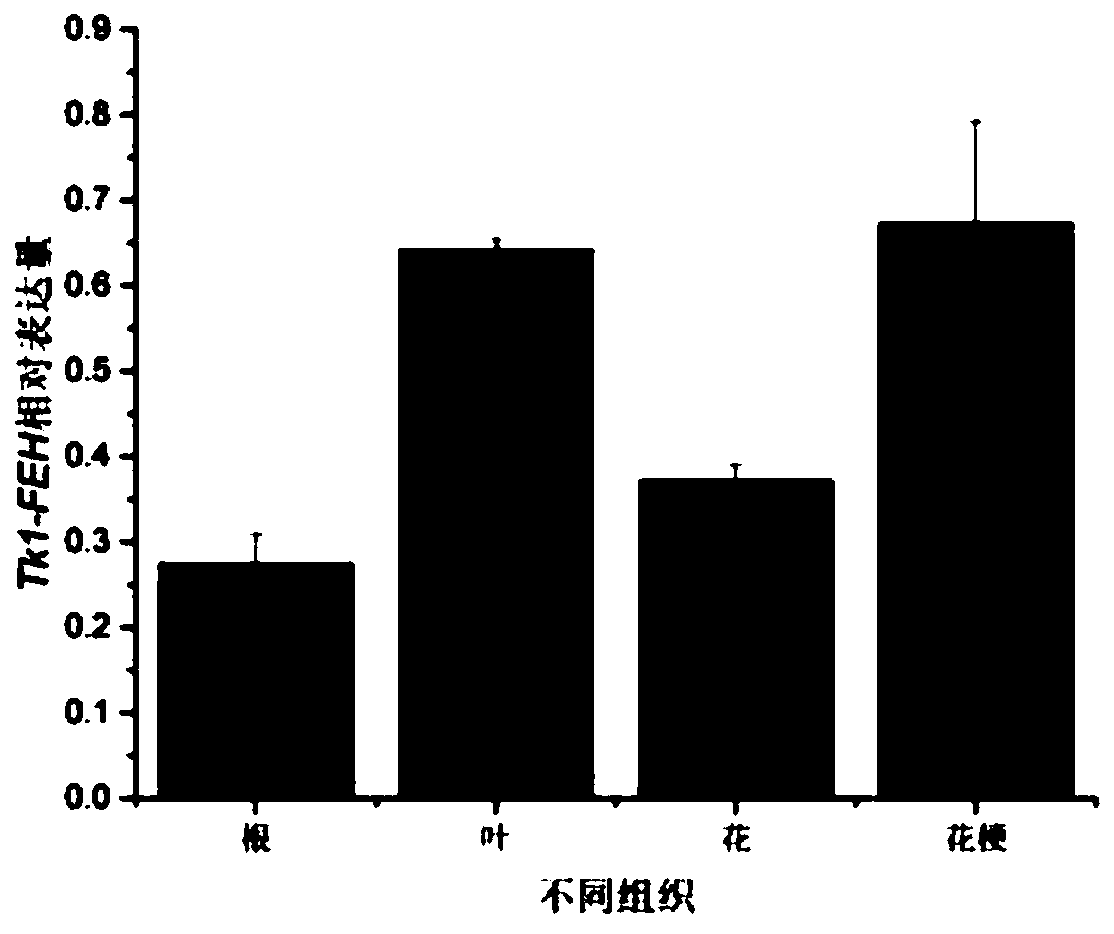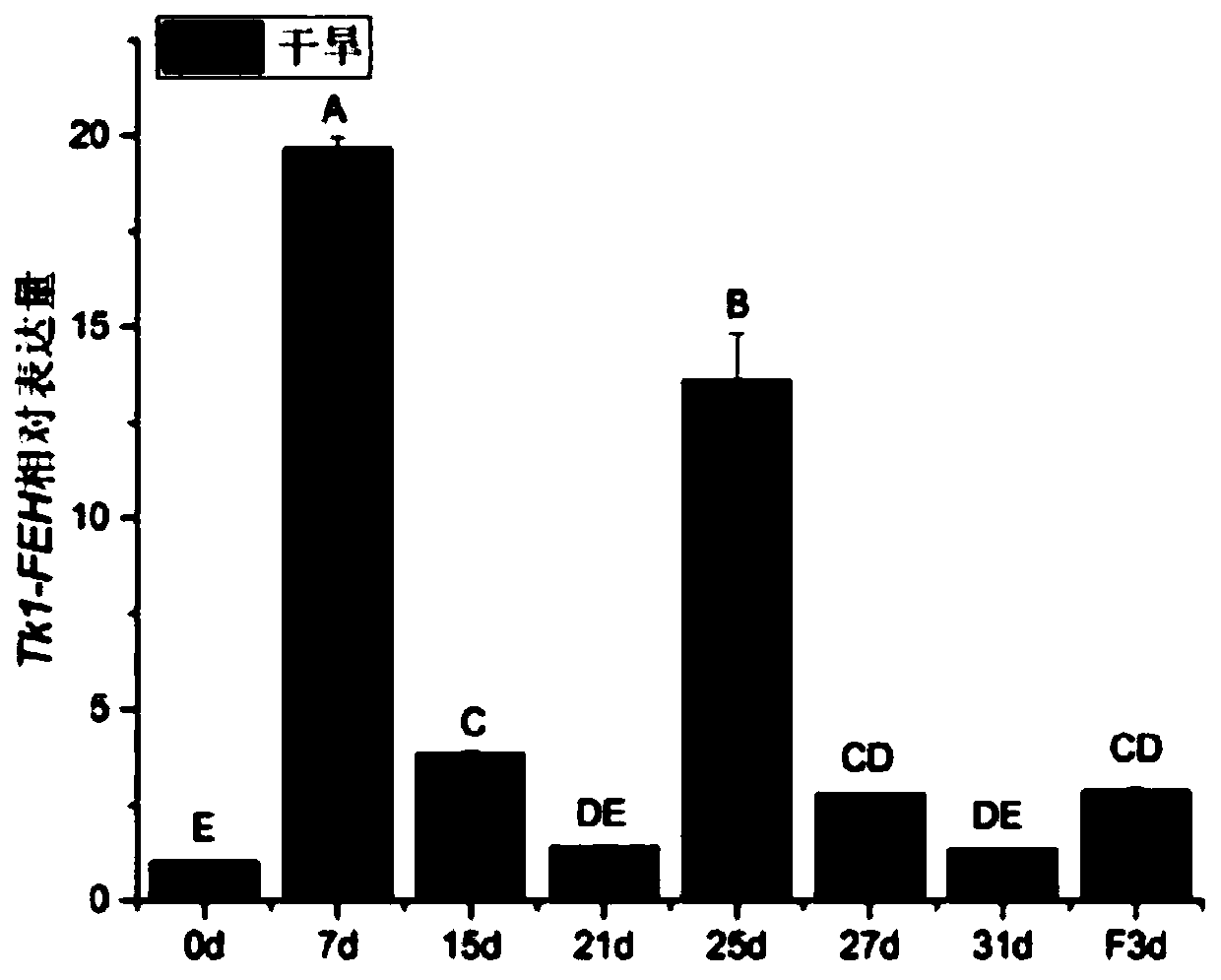Taraxacum kok-saghyz inulin degrading enzyme gene Tk1-FEH and application thereof
A technology for degrading enzymes and inulin, applied in the field of genetic engineering, can solve the problems of short domestication time, high cost, low gum content and low biomass, etc.
- Summary
- Abstract
- Description
- Claims
- Application Information
AI Technical Summary
Problems solved by technology
Method used
Image
Examples
Embodiment 1
[0042] Example 1 Cloning of rubber grass inulin degrading enzyme gene Tk1-FEH
[0043] The present invention utilizes RT-PCR technology to clone the rubber grass inulin degrading enzyme gene Tk1-FEH from the leaves of rubber grass high rubber content strain 2162, and the specific method is as follows:
[0044] 1. Extract the total RNA in rubber tree leaves, and reverse transcribe to obtain the first strand of cDNA.
[0045]2. Using the first strand of cDNA as a template and Tk1-FEH-F1 and Tk1-FEH-R1 as primers, the cDNA sequence of Tk1-FEH gene was obtained by PCR amplification reaction. The primer sequences are as follows:
[0046] Tk1-FEH-F1: 5'-ATGAGCAAGCCTCTTTCCTCC-3';
[0047] Tk1-FEH-R1: 5'-TTAAACTGTGCTTTTTACAGT-3'.
[0048] Using Premix Taq TM (TaKaRa) for PCR amplification, the reaction system is: cDNA template 1 μL, primers Tk1-FEH-F1 and Tk1-FEH-R1 (10 μmol / L) each 1 μL, 2×PCR Mix 10 μL, add ddH 2 0 to 20 μL.
[0049] The PCR amplification program was: denatura...
Embodiment 2
[0052] Example 2 Expression analysis of rubber grass inulin degrading enzyme gene Tk1-FEH under drought and other stresses
[0053] In this example, the fluorescent quantitative PCR method was used to detect the four tissues of rubber grass leaves, flowers, pedicels and roots, and the expression of Tk1-FEH gene in rubber grass leaves after being treated with drought, abscisic acid, PEG6000, ethephon and methyl jasmonate.
[0054] Drought treatment: First, water the rubber grass tissue culture seedlings transplanted for 3 months to saturation, and then put them in the light incubator for water cut-off treatment. 3-day-old (F3d) leaves were used as material.
[0055] Chemical agent treatment: take rubber grass tissue culture seedlings cultivated in hydroponic culture for one month as materials, soak the roots of the plants in 10 μM abscisic acid, 15% (w / v) PEG6000, 1% (v / v) ethephon and 200 μM jasmine acid methyl ester, leaf samples were taken at 0, 6, 12, 24, 48 and 72 hours, ...
Embodiment 3
[0065] Example 3: Obtaining Transgenic Tk1-FEH Gene Rubber Grass Plants and Identification of Root Biomass and Drought Resistance
[0066] This embodiment provides a method for constructing transgenic Tk1-FEH gene rubber grass plants, the specific steps are as follows:
[0067] (1) Using the Tk1-FEH-19T plasmid prepared in Example 1 as a template, Tk1-FEH-EcoRI-F and Tk1-FEH-XbaI-R as primers to amplify the ORF of the Tk1-FEH gene, the amplified product was subjected to EcoRI and After double digestion with XbaI, it was connected to the expression vector pCAMMBIA1300 after the same digestion, and the constructed recombinant plasmid was named Tk1-FEH-OE-1300.
[0068] The sequences of Tk1-FEH-EcoRI-F and Tk1-FEH-XbaI-R are as follows:
[0069] Tk1-FEH-EcoRI-F:5′-CG GAATTC ATGAGCAAGCCTCTTTCCT-3′ (the underline is the EcoRI restriction site)
[0070] Tk1-FEH-XbaI-R:5′-GC TCTAGA TTAAACTGTGCTTTTTACAGT-3' (the underline is the XbaI restriction site).
[0071] (2) The recombin...
PUM
 Login to View More
Login to View More Abstract
Description
Claims
Application Information
 Login to View More
Login to View More - R&D
- Intellectual Property
- Life Sciences
- Materials
- Tech Scout
- Unparalleled Data Quality
- Higher Quality Content
- 60% Fewer Hallucinations
Browse by: Latest US Patents, China's latest patents, Technical Efficacy Thesaurus, Application Domain, Technology Topic, Popular Technical Reports.
© 2025 PatSnap. All rights reserved.Legal|Privacy policy|Modern Slavery Act Transparency Statement|Sitemap|About US| Contact US: help@patsnap.com



